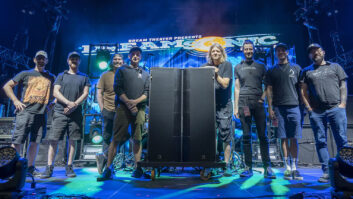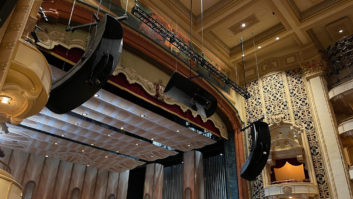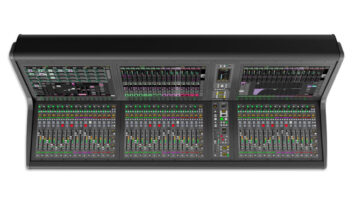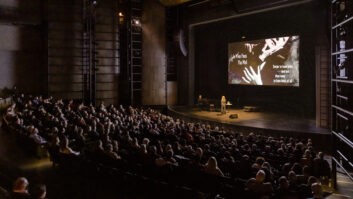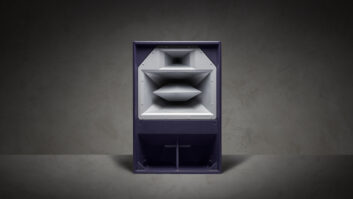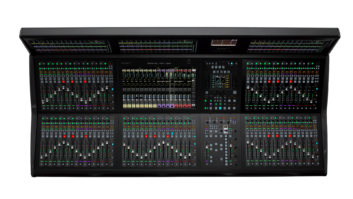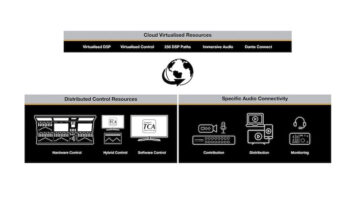In comparison to outdoor performance areas, sheds and large arenas, modern theaters tend to be very reflective audio environments, imposing significant character to any audio program that grace their stages. And by “character,” we usually refer to frequency-altering issues that sound system designers must acknowledge. In multipurpose theaters, install engineers face an added, greater challenge: There’s always a new production, each with widely different needs and overall SPL levels, among other varying day-to-day issues.
Clair Brothers Audio Systems installed a sizable JBL Professional VTX line array system at New York City’s 6,000-seat The Theater at Madison Square Garden. For these reasons, building out a flexible theater sound rig begs for careful choices, most commonly employing line array systems. Manufacturers including d&b audiotechnik, JBL Professional, L-Acoustics, Martin Audio and Renkus- Heinz have researched the market’s needs and developed system configurations to systematically correct for zone-based frequency variations, thus providing equitable coverage throughout a theater, sometimes within a 2 dB SPL variance from any one seat to another, anywhere in the house. As a result, each staff or visiting mixer is allowed the comfort of knowing his mix is everyone else’s, too.

With a history of work in theaters, the engineering team at Clair Brothers Audio Systems is well versed in applying line array technology to complex, large and overall acoustically challenging rooms. By installing a well-designed line array, “we’re giving mixers a solid foundation to build on,” explains Jim Devenney, Clair senior engineer. Clair’s work on The Theater at Madison Square Garden, one of MSG Entertainment’s key venues, is an ideal example of this: Devenney and his team had an early opportunity to utilize the new JBL VTX line array system. As it is the biggest theater in Manhattan—hosting a broad range of acts in its 6,000 seat, balcony-less, low-ceiling environment— the necessary wide main PA placement required careful selection of a strong center cluster, two rings of delays, and sideboxes.
“The very nature of the line array—not having to set up a bunch of point-and-shoot boxes—reduces comb-filtering across the listening area,” explains Devenney. “There’s no setting up longer-throw boxes across the top, and—because the theater is so wide—you’d have to have an array of a couple of boxes wide, so there would be comb-filtering between them, too. The line array just makes the coverage area smoother. Being prepared for anything from the Muppets to the Who, we also had to make sure the system was powerful enough to handle anything,” recalls Devenney. “With the new Crown Audio I-Tech HD 4 X 3500 amplifiers and VTX sub-lows (hanging four per side), we were insured that we had it covered. It’s easier to scale back than to scale up.”


Specing a system that will assure visiting engineers is always a good move, but sometimes being one of those visiting engineers can provide some insight as well. After serving audio needs at George Washington University’s 1,500 seat Lisner Auditorium for 20 years, Maryland-based MHA Audio owner Mike Scarfe recommended configuring a Martin Audio MLA Compact line array system for the venue’s unique sonic characteristics and needs. “Having a history there, and by knowing the cross-section of entertainment they host, choosing the system was straightforward,” he said. “I’ve personally been using Martin Audio MLA for a little over two years now, so it was a no-brainer for me to suggest they step up their game and go with this ground breaking technology.”
De Grote Post, a performing arts center in Belgium, has the first European installation of Renkus-Heinz’s VARIA modular point source line array. Fewer Boxes, More Coverage

Belgium’s Oostende Post Office—a modernist, former public building considered one of that country’s finest post-war architectural endeavors—now hosts De Grote Post, a multipurpose performing arts center with slightly over 400 seats, redesigned for music, dance and traditional theater. It also marks the first European installation of Renkus-Heinz’s VARIA modular point source line array, with four VARIA VA101 cabinets per side, a two 22.5-degree cabinet center cluster, and a third cabinet ground stacked atop two VA15S subwoofers. Four TRX61 loudspeakers provide front fill for the first few rows.
Steven Kemland of Foundation for Audiovisual Commerce and Engineering (FACE)—De Grote Post’s systems provider— explained, “Most of the systems we looked into would have required many more cabinets to provide even coverage across the entire seating area. The VARIA’s variable coverage patterns enabled us to configure a system with fewer boxes than a traditional line array. It’s very compact and yet it sounds like a much larger system.”
Multi-brand System Selection
Masque Sound—the New Jersey-based theatrical sound reinforcement, installation and design company—tackles a variety of summer theater festivals around the country, ranging from the Williamstown Theatre Festival in Massachusettes, which it has handled for over a decade, to the high-profile “Shakespeare in the Park” festivities at the Delacorte Theater in New York, to The Muny in St. Louis. For the Williamstown Festivals, sound supervisor Alex Neumann confirms that a carefully chosen amalgamation of Meyer Sound, d&b audiotechnik, and L-Acoustics speakers— including Meyer M’elodie line arrays, UPQ-1ps and UPQ-2ps, d&b audiotechnik E0s, E4s and E9s, L-Acoustics 108ps and DV subs—covers its 511-seat main theatre, proving line array selection can be customizable.
“On the two main stages, we turn over shows in 24 hours, so we need to make sure the sound equipment we are using can hold up to the rigors of our crazy schedule,” Neumann explained. “Equipment selection is essential and knowing that Masque Sound consistently provides reliable and well-built gear allows me to focus my attention elsewhere. That is a huge help.”
“Although we provide unique audio equipment setups, our goal is to supply the sound designers with the flexible, customized equipment packages they need to create an environment in which every audience member feels a connection to the show,” confirmed Dennis Short of Masque Sound.
Keeping Out Of Sight In Mind
George Washington University’s 1,500 seat Lisner Auditorium recently updated its audio system with a Martin Audio MLA Compact line array system installed by MHA Audio. Somewhat like house-of-worship environments, where aesthetics and sightlines are almost literally and figuratively sacred, theater loudspeaker installs are often presented with some unalterable acoustic tendencies to work around—yet another good reason for going line array, as Clair’s Devenney noted about the Theater at Madison Square Garden installation. “One thing that [MSG Entertainment’s] Tom Arrigoni and I wanted to make sure of was that the center cluster could keep up with the main PA. [Because the ceiling is so low], we couldn’t put up large delay speakers. Sixteen high powered JBL AM7112 with a narrower pattern, 60 degrees wide, served us well; we could put more of them in with less overlap. It allowed us to get more power to the delays in the first delay ring. In the second delay ring, in the raised ceiling area with low ceilings and restricted sight lines, we had the same number. One of the main challenges is to get power to the back in low ceiling, deep room situations.”

New Technology in Set Spaces
At Lisner Auditorium, Scarfe deployed cutting-edge line array technology in a traditional theater environment: “Lisner Auditorium was certainly designed to project unamplified content from the stage; it’s a very live room. Using Martin Audio’s proprietary Display2 optimization process, I was able to designate the back wall of the auditorium as a ‘hard avoid’ area and the ceiling as a ‘non-audience area, minimizing reflections from those two surfaces.”
“Other than a little bit of acoustic treatment on the back wall, there was none, and it wasn’t in the scope of this project,” continued Devenney on the sheer size of MSG’s Theater. “The acoustics are what the acoustics are. It’s a city block wide with low ceilings for a venue with that many seats. Usually theaters are stacked up with balconies, and there are none here. You take all those seats that balconies add and bring people closer, and it makes the room fan-shaped, deep and wide. We covered it well with delays, making sure that it is even in all places.”
Benefitting from Balance
A more even coverage throughout a theater allows visiting engineers to mix with confidence. At MSG’s Theater, “the mix position is kind of close to the stage, compared to most theaters where you are close to the back, even under the balcony,” said Devenney. “You’re close to the stage, at the edge of the coverage of the main PA, but the center field helps. It’s a great place to mix.”
Scarfe touted MLA’s ability to provide consistent sound throughout the venue, and the fact that the farthest seat from the stage receives the same sound quality as the front row serves the historic Lisner Auditorium well; he recently engineered an outdoor MLA-based spoken word event where, at 350 feet from the stage, SPL was only 2 dB down from the podium, with no delays. “In these cases, gain before feedback is always an issue,” he notes, adding that ”MLA is really the only option to get this kind of controllable decibel balance throughout such venues.”
